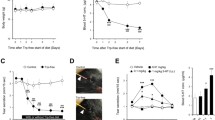Abstract
Keratoconjunctivitis sicca, or dry eye, is characterized by decreased lacrimal fluid secretion. Since this disease is more prevalent in females than males, it has generally been assumed that the sex hormones are involved in its etiology. The sex steroids and the sexually dimorphic peptide hormone prolactin have been under investigation. There have been several reports that reveal a negative correlation between high levels of prolactin and lacrimal gland function. Studies with hypophysectomized rats1 and with human subjects suggest that excessive levels of circulating prolactin (PRL) impair lacrimal secretion.2 Prolactin levels are higher in females than males and rise during pregnancy, in accord with decreased lacrimal function (Schechter et al., unpublished data). Prolactin also seems to be closely linked to autoimmune diseases such as Sjögren’s Syndrome. Big prolactin, 60kD, is found to be overexpressed in salivary glandular epithelial cells of Sjögren’s syndrome patients,3 and hyperprolactinemia is found in 46% of patients with primary Sjögren’s syndrome.4 In addition, both prolactin and prolactin receptors are synthesized in the lacrimal gland,5 and PRL has been detected in human tears,6 suggesting that prolactin plays endocrine, paracrine, and autocrine roles in lacrimal gland function and maintenance of the ocular surface.
Access this chapter
Tax calculation will be finalised at checkout
Purchases are for personal use only
Preview
Unable to display preview. Download preview PDF.
Similar content being viewed by others
References
A.M. Azzarolo, K. Bjerrum, C. Maves, L. Becker, R. Wood, A. Mircheff, and D. Warren. Hypophysectomy induced regression of female rat lacrimal glands: partial restoration and maintenance by dihydrotestosterone and prolactin. Invest. Ophthalmol Vis. Sci. 36: 216–226 (1995).
W. Mathers, D. Stovall, J. Lane, M. Zimmerman, and S. Johnson. Menopause and tear function: the influence of prolactin and sex hormones on human tear production. Cornea: 17: 353–358 (1998).
S. Steinfeld, S. Rommes, C. Francois, C. Decaestecker, A. Maho, T. Appelboom, C. Heizmann, R. Kiss, and R. Pochet. Big prolactin 60kD is over-expressed in salivary glandular epithelial cells from patients with Sjogren’s Syndrome. Lab. Invest. 80: 239–247 (2000).
M. Guttierrez, J. Anaya, E. Scopelitis, G. Citera L. Silveira, and L. Espinoza. Hyperprolactinemia in primary Sjogren’s Syndrome. Ann. Rheum. Dis. 53: 425 (1994).
R.L. Wood, J. Zhang, J.P. Gierow, J.E. Schechter, A.K. Mircheff, and D.W. Warren. Prolactin and prolactin receptors in the lacrimal gland. Exp. Eye Res. 69: 213–26 (1999).
W.H. Frey, J.D. Nelson, M.L. Frick, and R.P. Elde. Prolactin immunoreactivity in human tears and lacrimal gland: possible implications for tear production, in: The Preocular Tear Film in Health, Disease, and Contact Lens Wear, F.J. Holly, ed., Dry Eye Institute, Lubbock (1986).
M. Sasaki, and J. Enami. Mammary fibroblast-derived hepatocyte growth factor and mammogenic hormones stimulate the growth of mouse mammary epithelial cells in primary culture. Endo. J. 46: 359–66 (1999).
Y.J. Lee, and C.H. Streuli. Extracellular matrix selectively modulates the response of mammary epithelia cells to different soluble signaling ligands. J. Biol. Chem. 274: 22401–8 (1999).
G.M. Edwards, F.H. Wilford, X. Liu, L. Hennighausen, J. Djiane, and C.H. Streuli. Regulation of mammary differentiation by extracellular matrix involves protein-tyrosine phosphatases. J. Biol. Chem. 273: 9495–500 (1998).
Z. Guo, D. Song, A.M. Azzarolo, J.E. Schechter, D.W. Warren, R.L. Wood, A.K. Mircheff, and H.R. Kaslow. Autologous lacrimal-lymphoid mixed-cell reactions induce dacryoadenitis in rabbits. Exp. Eye Res. 17:23–31(2000).
P.B. Koduri, and J.A. Rillema. Effects of cholera and pertussis toxins on prolactin stimulation of lactose synthesis and ornithine decarboxylase activity in mouse mammary gland expiants. Proc. Soc. Exp. Biol. Med. 203: 424–7 (1993).
M.A. Meneray, T.Y. Fields, and D.J. Bennett. Gi/Go couple met-enkephalin to inhibition of cholinergic and α-adrenergic stimulation of lacrimal secretion. Cornea 19: 92–98 (2000).
Author information
Authors and Affiliations
Editor information
Editors and Affiliations
Rights and permissions
Copyright information
© 2002 Kluwer Academic/Plenum Publishers
About this chapter
Cite this chapter
Casbon, A.J., Warren, D.W., Mircheff, A.K. (2002). Prolactin Inhibits Carbachol-Dependent Secretion by Lacrimal Acinar Cells in Vitro. In: Sullivan, D.A., Stern, M.E., Tsubota, K., Dartt, D.A., Sullivan, R.M., Bromberg, B.B. (eds) Lacrimal Gland, Tear Film, and Dry Eye Syndromes 3. Advances in Experimental Medicine and Biology, vol 506. Springer, Boston, MA. https://doi.org/10.1007/978-1-4615-0717-8_31
Download citation
DOI: https://doi.org/10.1007/978-1-4615-0717-8_31
Publisher Name: Springer, Boston, MA
Print ISBN: 978-1-4613-5208-2
Online ISBN: 978-1-4615-0717-8
eBook Packages: Springer Book Archive




